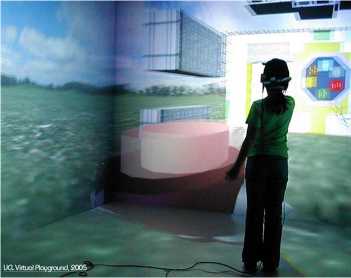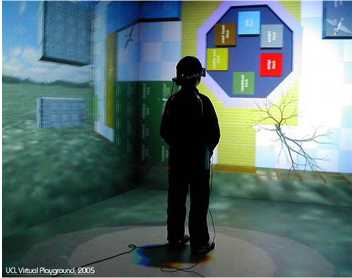18. Observer: Towards the fence or towards the sandpit?
19. Julie: Towards the fence.
She returns to ground view and attempts to place a block on the side of the
swing area that is near the fence. This triggers the system feedback message:
"This is too close to the fence".
20. Julie: Ok, so, on that side... but we can't do it on that side... I think I have to
use the whole shape cause that's too close to the sandpit.
21. Julie: Ok, I know what I wanna do. I think. I'm going to bring... [thinking]
ok, no, it's going to say “too close to the path...” cause if I put these three I think
still it's gonna be too close... cause there's four here [meaning four free tiles] that
might say the shape's not right...
22. Observer: You mean that it's not going to be a whole shape...
23. Julie: Wait, how much do I have to put, three or four? four! oh! we should
do one third, cause one third of twelve gives us four and it'll complete a proper
shape.
24. Observer: How come you didn't think about this from the beginning?
25. Julie: Cause the number four is bigger than three so it just came to my mind
straight away.
26. Observer: You mean one fourth is...?
27. Julie: Just cause the number's bigger it just came to my head straight away.
Meanwhile, Julie has picked four blocks and has placed them one by one in
the correct area.
28. Julie: Ok, red button!
Upon clicking on the red button, the model for the swings replaces the blocks
that comprise that area, and Julie completes her task in the playground.

Figure 9. Children using the top-down view to plan the layout of the playground.

19
More intriguing information
1. Transfer from primary school to secondary school2. The name is absent
3. Party Groups and Policy Positions in the European Parliament
4. The name is absent
5. The name is absent
6. Creating a 2000 IES-LFS Database in Stata
7. The name is absent
8. Group cooperation, inclusion and disaffected pupils: some responses to informal learning in the music classroom
9. Do the Largest Firms Grow the Fastest? The Case of U.S. Dairies
10. The name is absent